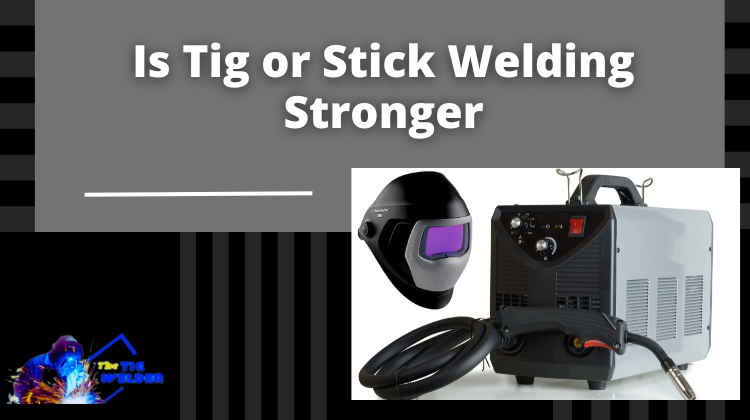TIG welding, also known as Tungsten Inert Gas welding, is a type of welding that uses a non-consumable tungsten electrode to produce the weld. The electrode is shielded by an inert gas, such as argon or helium, which protects the weld pool from contamination. TIG welding is known for its precise, high-quality welds and is often used for thin materials or materials that require a visually appealing weld.
Stick welding, also known as shielded metal arc welding (SMAW), uses an electrode coated in flux to produce the weld. The flux creates a protective gas shield around the weld pool and helps remove impurities from the weld. Stick welding is a versatile and affordable option, but it is less precise than TIG welding and can produce slag on the weld bead.
The strength of a weld is important in construction and manufacturing because it determines the structural integrity of the finished product. A weak weld can fail under stress, leading to costly repairs or dangerous accidents. Therefore, choosing the appropriate welding process and techniques is important to ensure that the welds are strong enough for the intended use.

TIG Welding
TIG welding is a type of welding that uses a non-consumable tungsten electrode to produce the weld. The tungsten electrode is held by a welding torch and is used to strike an arc with the workpiece. The arc melts the workpiece and the tungsten electrode, forming the weld pool.
One of the key advantages of TIG welding is its precision. The tungsten electrode allows for a very small and concentrated arc, which makes it easy to control the size and shape of the weld bead. This makes TIG welding well-suited for thin materials or materials that require a visually appealing weld, such as stainless steel or aluminum.
TIG welding is also known for producing clean welds. The inert gas, such as argon or helium, shields the weld pool from contamination and helps to remove impurities from the weld. This results in a smooth, clean weld bead with minimal spatter or slag.
However, TIG welding can be slower than other welding processes, such as stick welding or MIG welding. It also requires a higher skill level, as the welder must manually feed the filler material into the weld pool and control the arc. Additionally, TIG welding equipment can be more expensive than other types.
Stick Welding
Stick welding, also known as shielded metal arc welding (SMAW), uses an electrode coated in flux to produce the weld. The welder holds the electrode and is used to strike an arc with the workpiece. The arc melts the workpiece and the electrode, forming the weld pool.
One of the main advantages of stick welding is its versatility. Stick welding can be used on many materials, including steel, cast iron, and aluminum. It can also be used in various positions, including flat, vertical, and overhead. This makes it a good choice for field work or welding in tight spaces where other welding processes may not be practical.
Stick welding is also affordable, as the equipment is generally less expensive than other types of welding equipment. It is also relatively easy to learn, making it a popular choice for beginner welders.
However, stick welding is less precise than TIG welding and can produce a less visually appealing weld. It can also produce slag on the weld bead, which must be chipped or ground off before it is considered complete. Stick welding also requires more post-weld cleaning and maintenance, as the flux coating on the electrode can leave a residue on the workpiece.
Comparison of Tig and Stick Welding Strength
Several factors can affect the strength of a TIG or stick weld, including the material being welded, the thickness of the material, the shape of the weld bead, and the condition of the equipment. In general, TIG welding tends to produce stronger welds than stick welding due to the precise control and cleanliness of the process.
However, there are also situations where stick welding may be stronger than TIG welding. For example, stick welding may be stronger when the material is heavily contaminated or has a rough surface, as the flux coating on the electrode helps remove impurities and smooth the surface. Stick welding may also be stronger when the material is thick or heavily stressed, as the wider, deeper weld bead produced by stick welding can provide more support.
Several studies and tests have compared the strength of TIG and stick welds in various applications. These studies have found that TIG welds tend to be stronger than stick welds, but the specific strength of a TIG or stick weld will depend on the abovementioned factors.
It is important to consider a project’s specific needs and requirements when deciding between TIG and stick welding. TIG welding is generally a good choice for precise, high-quality welds on thin materials. In contrast, stick welding is a good choice for versatility and affordability on a wide range of materials.
Conclusion
In conclusion, TIG and stick welding are both important processes with their strengths and drawbacks. TIG welding is known for its precision and cleanliness, making it a good choice for thin materials or materials that require a visually appealing weld. However, TIG welding can be slower and more expensive than other welding processes, requiring a higher level of skill.
Stick welding is a versatile and affordable option for various materials and positions. However, stick welding is less precise than TIG welding and can produce a less visually appealing weld with slag on the bead. It also requires more post-weld cleaning and maintenance.
The strength of a TIG or stick weld will depend on the specific material being welded, the thickness of the material, the shape of the weld bead, and the condition of the equipment. TIG welds tend to be stronger than stick welds, but there are also situations where stick welding may be stronger.
When deciding between TIG and stick welding, it is important to consider the specific needs and requirements of the project. The appropriate welding process should be chosen based on the materials being welded, the desired appearance of the weld, and the budget and time constraints of the project.

It’s been years since I got into welding as a side hustle. It’s been so long since Doing All kinds of welds for business and pleasure as this is my hobby. Being in this field I have learned from hands-on-experience also came to know what gears work and what doesn’t. The Tig Welder is my own platform where I use to share my experience.






Leave a Reply